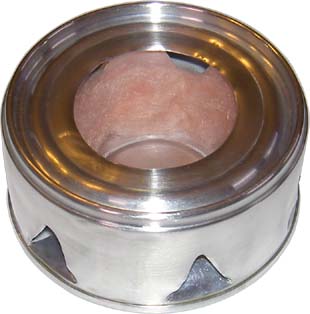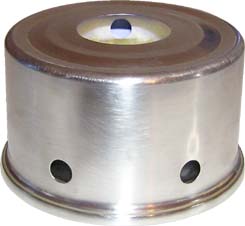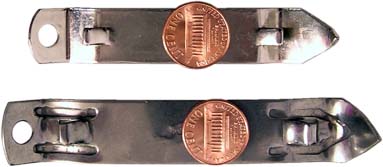|
|
|
|
Contact:
aka - Cat Can Stove and The Cat Stove
The Cat Can Stove (or Tuna Can Stove) is known for its high heat output (for an alcohol stove) and fast cook times. It's one of the simplest designs and is very easy to construct and quite dependable.
Advantages -
Very easy to construct.
Works with any sized pot.
More efficient than sideburner stoves for narrow pots.
Easiest to light.
Very dependable.
Many simmer options.
Works.
Easy to find parts.
Can light without primer pan.
Drawbacks -
Requires a pot stand.
Slightly more bulky than other alcohol stove designs.

The most popular double jacketed alcohol stove is the Cat Can Stove by 2001 Triple Crown Roy L. "TrailDad" Robinson. There are a few variants, but the basic design remains the same - an inner ventilated can with fiberglass insulation for a wick encompassed by a larger diameter can with low lying ventilation. Fuel is vaporized and drawn upwards through a central opening where it ignites creating a low pressure zone that in turn draws fresh air in through the lower side vents.
This stove above is made of a 5.5oz and 3oz aluminum can (cat food) and a piece of fiberglass insulation. Six to eight holes are punched through the sides of each can with either a "church key" or a hole punch. Fiberglass insulation in placed in the smaller can and the two pieces are assembled as shown.
Acceptable fuels include denatured alcohol (ethanol), HEET (methanol) and others (see Fuel Options). It requires a pot stand or rocks to hold the pot about 1-1.5inches for the top of stove.
Simmering is fairly easy to do, requiring that you block or partially block the inlet vents and/or limit the size of the exit port on top of the stove. You can block with the side inlet vents with a simmer ring and you can limit the size of the outlet port on top by placing a cutout can bottom from a second 5.5oz aluminum can with a hole (or several small holes) cut in it (or something similar - such as a piece of foil) on top of the stove.

Here is a miniature version made from a 3oz cat food can, 5.5oz V8 can and a circular piece of aluminum flashing JB Welded to the bottom to seal it and keep the inner chamber from shifting. Punching holes with a hole punch in lieu of a church key is mostly for aesthetics, but also allows for a better seal if you use a simmer ring around the circumference of your stove. This design is a modified version of John Bednar's Turbo Cat II Stove (Old Site).
Notable versions include:
SGT Rock's Cat Food Can Alcohol Stove
John Bednar's Turbo Cat II Stove
Fritz Krueger's Tuna Can Stove
J Falk's Super Simple Cat Stove
The Ron & Don Cat Food Can Alcohol Stove
Jim Crandall's Mini Cat Can Stove
rioleichtsinn.wordpress.com myog-cone-brenner-gastautor-quasinitro - German page - quasi-nitro's "Cone - Brenner" - dual walled Zen Chimney Stove
Scott Bryce's Yet Another Alcohol Stove
Note - This is just one of the many DIY alcohol stove options. For more information on different options visit Zen and the Art of the Alcohol Stove and the Templates page.
Construction

The following illustrated step by step instructions are based on the original Cat Can Stove by "TrailDad" Robinson which requires a 5.5oz and 3oz aluminum cat food can and a small section of fiberglass insulation.
After you open and empty your two cans, you will want to wash out any food residue and use an SOS pad to smooth out the razor sharp edge around the can opening.

To make the ventilation holes, you will need two different sized "church key" type can openers.
The can openers used in the photo above are 15.5mm and 18.5mm wide 87mm and 106mm long respectively.

A template will help you space out your ventilation holes evenly.

Use the small church key can opener to make 6 vent holes in the 3oz can as shown above.
The small church key makes a smaller shorter hole than a regular church key which allows for more insulation and fuel in your stove.
Option - you can use a hole punch in lieu of the small church key. If you decide to do this, 8 1/4inch holes should be sufficient.

After you have punched out your 6 holes, flatten the wings and round off the edges with a pair of scissors.
Rounding the edges will allow for a firmer fit in the 5.5oz can and is a good idea in the interest of safety.
It would be a good idea to use an SOS pad to smooth out all the new razor sharp edges.

Cut a small section of fiberglass insulation to hug the inside wall of the 3oz can. This band of insulation will act as a wick and should not obstruct the ventilation holes.

Use a sharp knife to score around the indentation on the bottom of the 5.5oz can.
Use light pressure and go around a few times.
Option - you can use a circle template to help make a smaller top opening.

Use your knife to start a small cut along the score line.

When your starter cut is sufficiently long enough, use the back of your knife handle to tear around the score line.
The hole created here will be used for your fuel port and is razor sharp. It would be a good idea to use an SOS pad to smooth it out so that it doesn't end up cutting your fingers while on the trail.

Use the large church key can opener to punch 6 ventilation holes in the 5.5oz can as shown above.
Option - you can use a hole punch in lieu of the church key. If you decide to do this, 8 1/4inch holes should be sufficient.
Holes made from a hole punch (or a drill) generally don't deform the side of the can as much as a church key and is easier to seal with a sidewall simmer ring. The problems with using a hole punch here is that you lose the tabs created by a church key needed to lock the stove parts together. You can either just have two separate stove parts, or get creative and epoxy the parts to a stove bottom.

Use a pair of scissors to round off the points of your 6 ears and use an SOS pad to smooth all of your new edges.

Place your 3oz can on your 5.5oz can, align it as shown above and press them together.

This is what it should look like when the two pieces are put together.
Ensure everything is centered and adjust the metal ears as necessary.
Option - you can epoxy (JB weld) a bottom onto your stove to create a better seal if you decide to use a sidewall simmer ring.

All you need now is some fuel and a pot stand.